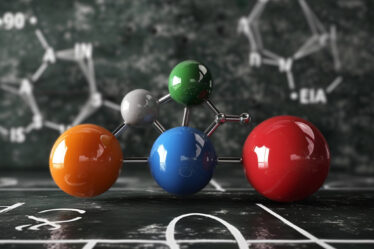
How do you compare the mass of an atom when it’s too small to weigh directly?
Scientists use the relative atomic mass, which compares an element’s mass to carbon-12. This method accurately describes atomic masses without units, helping you work with chemical equations and formulas.
We will explore the concept of relative atomic mass, how to calculate it, and its connection to isotopes. You’ll learn the difference between relative atomic mass and atomic weight, its historical background, and practical applications in chemistry. Examples and formulas will help you connect these ideas to real-world chemical problems.
Relative Atomic Mass: Quick Summary
Do you just need the basics? Here’s a simple explanation of what is a relative atomic mass or Ar:





What Is Relative Atomic Mass?
Relative atomic mass (
The Definition of Relative Atomic Mass
Relative atomic mass (
For instance, carbon’s
Relative Atomic Mass, Atomic Weight, and Isotopic Mass
Many confuse relative atomic mass with atomic weight or isotopic mass. Atomic weight refers to a standard atomic weight that averages samples from Earth’s crust, atmosphere, and oceans.
Relative isotopic mass, on the other hand, measures the mass of a specific isotope relative to carbon-12 and ignores natural abundance.
Relative atomic mass combines these factors, making it a practical tool for most chemical calculations.
Comparison of Related Terms
| Term | Definition | Example |
| Relative Atomic Mass ( |
Weighted average mass of an element’s isotopes relative to |
|
| Atomic Weight | The standard average mass of an element across terrestrial samples. | Atomic weight of chlorine = 35.45 |
| Relative Isotopic Mass | Mass of a specific isotope relative to |
By mastering these distinctions, you can confidently interpret periodic table values and apply
How To Calculate Relative Atomic Mass
Relative atomic mass (
The formula for relative atomic mass is:
Steps for Calculating
- Identify the isotopes present in the element and their isotopic masses.
- Determine the percentage abundance of each isotope.
- Convert the percentage abundance into decimals (e.g.,
- Multiply each isotope’s mass by its decimal abundance.
- Add the resulting values to get the relative atomic mass.
Example 1: Calculating Relative Atomic Mass for Chlorine
1. Gather isotopic data (Chlorine consists of two stable isotopes):
2. Convert abundances into decimals:
3. Calculate the contributions:
4. Add the contributions:
The relative atomic mass of chlorine is
Example 2: Calculating Relative Atomic Mass for Oxygen
1. Gather isotopic data (Oxygen consists of three stable isotopes):
2. Convert abundances into decimals:
3. Calculate the contributions:
4. Add the contributions:
The relative atomic mass of oxygen is approximately
Isotopic Variations Across Samples
Isotopic composition varies based on the sample source, affecting
The calculation follows the formula:
Breaking it down:
Adding these values gives:
Samples from different environments can have slightly different isotopic distributions. For example, silicon in terrestrial rocks may differ from silicon in extraterrestrial samples. These variations impact the calculated
Isotopes and Relative Atomic Mass
Isotopes affect the relative atomic mass (
For example, boron exists as
This shows how isotopic distribution influences
Monoisotopic vs. Multi-Isotopic Elements
Elements with a single isotope, like fluorine (
For instance, the relative proportions of
Applications of Isotopic Composition
Isotopic composition has practical applications in geochemistry and nuclear science. In geochemistry, isotope ratios help trace the origin of materials and reveal changes in the environment over time.
For example, analyzing carbon isotopes provides insights into climate history. Nuclear science uses isotopic data to design fuels and optimize energy production. Calculating accurate relative atomic mass (
Applications of Relative Atomic Mass
Relative atomic mass Ar is essential in chemistry, especially in calculating molar masses and stoichiometric calculations. By combining
Applications of Ar in Chemistry
- Determining Molar Mass: Use
- Stoichiometry: Balance chemical equations by comparing reactant and product amounts.
- Isotopic Analysis: Study isotopic ratios for geochemistry or nuclear science applications.
- Industrial Processes: Use
Relative Molecular Mass (
The
- For water (
- For sodium chloride (
These calculations help you find the mass of one mole of a substance, allowing precise preparation of solutions and compounds.
Role in Chemical Reactions
In reactions,
With the
Historical Context of Atomic Weight
The term “atomic weight” was once widely used to describe the relative masses of elements. In early measurements, hydrogen served as the standard, being the lightest element. By 1961, scientists adopted carbon-12 as the reference standard, assigning it a value of exactly 12 atomic mass units. This change provided a more stable and universally accepted benchmark.
The introduction of carbon-12 shifted the terminology from “atomic weight” to “relative atomic mass” (
Despite the update, “atomic weight” is still used informally, creating occasional confusion. The debate over terminology reflects the evolution of scientific precision. The adoption of carbon-12 has ensured consistency and accuracy in atomic mass measurements, which are now integral to both chemistry and physics.
Advance Your Knowledge of Relative Atomic Mass
Are you struggling with relative atomic mass or Ar? You can find more useful topics in our Chemistry blogs. Or find a tutor, who can explain it in a way that clicks for you.
Search for a tutor using phrases like “chemistry tutor Edinburgh” or “chemistry teacher Liverpool” on platforms like meet’n’learn. You’ll find someone who can tailor lessons to your needs.
If you prefer learning in a group, search for “chemistry classes Leeds” or “chemistry lessons London” online. The search will lead you to chemistry tutoring nearby.
Relative Atomic Mass: Frequently Asked Questions
1. What is relative atomic mass?
Relative atomic mass (
2. How do you calculate relative atomic mass?
You calculate
3. How is relative atomic mass different from atomic weight?
Scientists use relative atomic mass as the correct term, while atomic weight is an outdated name for the same concept.
4. Why do scientists use carbon-12 as a standard?
Carbon-12 provides a reliable and consistent reference for measuring atomic masses.
5. How do isotopes influence relative atomic mass?
Isotopes change
6. How do monoisotopic and multi-isotopic elements differ in
Monoisotopic elements like fluorine have a fixed
7. What does relative molecular mass (
8. Why do chemists need relative atomic mass?
Chemists use
Sources:
1. ThoughtCo
2. Creative Chemistry
3. Wikipedia



